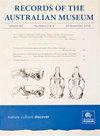Expanding population edge craniometrics and genetics provide insights into dispersal of commensal rats through Nusa Tenggara, Indonesia
IF 0.8
4区 生物学
Q4 ZOOLOGY
引用次数: 6
Abstract
The Nusa Tenggara island chain consists of an archipelago that runs roughly east-west in eastern Indonesia. As part of Wallacea, it has never been connected to any continental landmass, and has been subject to a variety of biological invasions that have populated the islands. Here, we examine the craniometric and molecular genetic records of several species of Rattus sensu lato in the island chain. We use the predictions of expanding population edge phenotypic selection in an effort to understand the movement of Rattus rattus and Rattus exulans through the archipelago. We also examine the mitochondrial haplotype networks of R. argentiventer, R. exulans, and the R. rattus Complex (RrC) and microsatellite allele frequency clustering patterns for the RrC, to examine relationships within and between Nusa Tenggara populations, and those of Asia and the Pacific where relevant for each taxon. In the RrC LIV and RrC LII haplotype networks, 20 haplotypes with seven from Nusa Tenggara were observed for RrC LIV, and 100 haplotypes with seven from Nusa Tenggara observed for RrC LII. The top performing RrC craniometric model had a negative association between size and distance from the easternmost point of the samples from Nusa Tenggara, consistent with increasing size moving west to east. The cytochrome b network for the R. exulans sequences comprised 14 haplotypes, with three observed from mainland Southeast Asia, one shared with Nusa Tenggara and regions further east, and another haplotype observed in Nusa Tenggara and in the Pacific. The R. exulans craniometric model selection produced four equally well performing models, with no migration scenario preferred. Finally, the haplotype network of R. argentiventer comprised 10 haplotypes, with six observed in Nusa Tenggara, including a relatively early cluster from the east of the archipelago. Our results are compatible with a polyphasic and polydirectional invasion of Nusa Tenggara by Rattus, likely beginning with RrC from the west to the east, an expansion of R. exulans from Flores, seemingly in no preferred overall direction, and finally the invasion of R. argentiventer from the east to the west. We find some support for the Dong Son drum maritime exchange network contributing to the distribution of the latter species.不断扩大的种群边缘颅骨测量和遗传学为共生大鼠在印度尼西亚努沙登加拉的传播提供了见解
努沙登加拉岛链由一个群岛组成,在印度尼西亚东部大致是东西走向的。作为Wallacea的一部分,它从未与任何大陆相连,并且一直受到各种生物入侵的影响。在此,我们研究了岛链上几种Rattus sensu lato的颅骨测量和分子遗传记录。我们利用扩展种群边缘表型选择的预测来理解Rattus Rattus和exulans Rattus在群岛中的运动。我们还研究了argentiventer, R. exulans和R. rattus Complex (RrC)的线粒体单倍型网络和RrC的微卫星等位基因频率聚类模式,以研究努沙登加拉种群内部和之间的关系,以及亚洲和太平洋地区与每个分类单元相关的种群。在RrC LIV和RrC LII单倍型网络中,RrC LIV共检测到20个单倍型,其中7个来自努沙登加拉;RrC LII共检测到100个单倍型,其中7个来自努沙登加拉。表现最好的RrC颅骨测量模型与努沙登加拉样本最东端的距离呈负相关,与从西向东增加的尺寸一致。该序列的细胞色素b网络包括14个单倍型,其中3个来自东南亚大陆,1个与努沙登加拉及其东部地区共有,另一个在努沙登加拉和太平洋地区观察到。大鼠颅骨模型的选择产生了四个同样表现良好的模型,没有迁移场景的首选。最后,argentiventer的单倍型网络包括10个单倍型,其中6个在努沙登加拉观察到,包括一个来自该群岛东部的相对较早的集群。我们的结果与Rattus对努沙登加拉的多相和多向入侵相一致,可能从RrC从西向东开始,R. exulans从弗洛雷斯扩张,似乎没有一个优先的总体方向,最后R. argentiventer从东向西入侵。结果表明,东山鼓海洋交换网络对后一种的分布有一定的支持作用。
本文章由计算机程序翻译,如有差异,请以英文原文为准。
求助全文
约1分钟内获得全文
求助全文
来源期刊
CiteScore
0.90
自引率
0.00%
发文量
9
审稿时长
>12 weeks
期刊介绍:
Records of the Australian Museum, volume 62 was published in 2010, volume 63 in 2011. Monographic works of particular significance are published irregularly as Records of the Australian Museum, Supplements (ISSN 0812-7387).

 求助内容:
求助内容: 应助结果提醒方式:
应助结果提醒方式:


